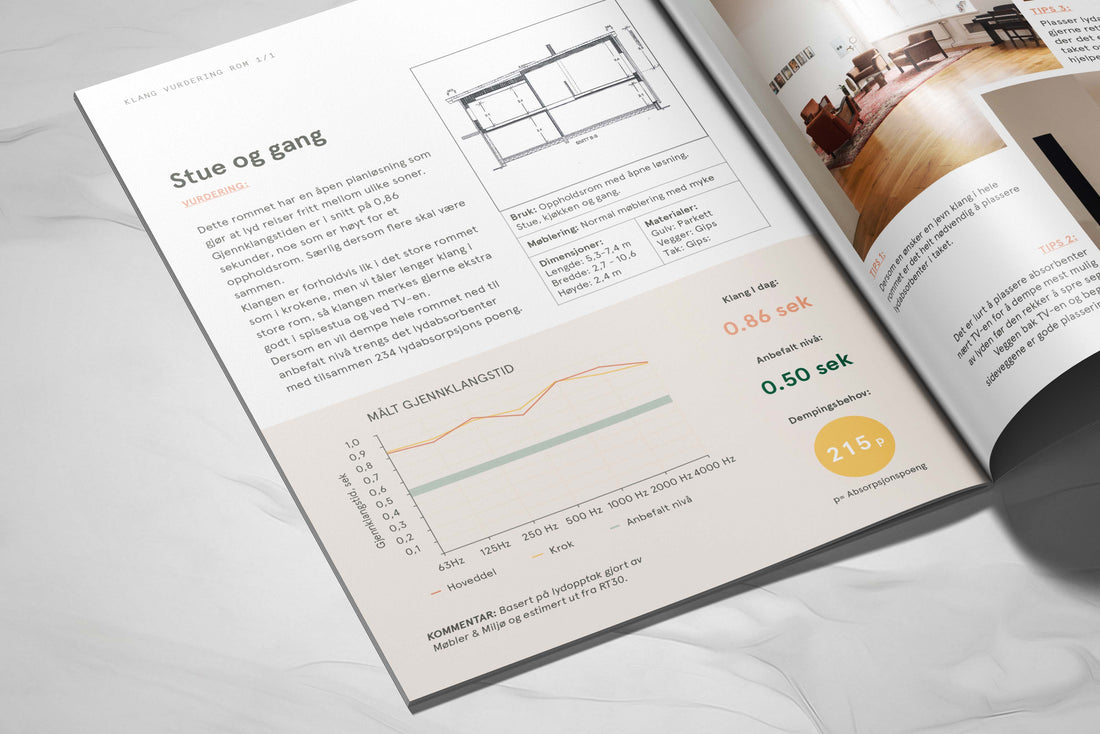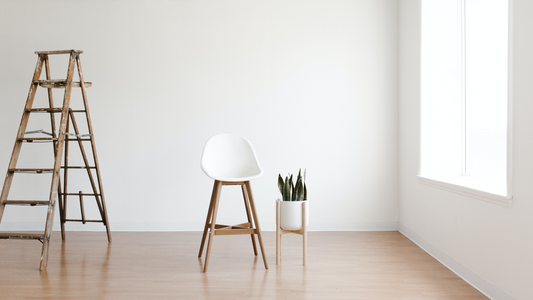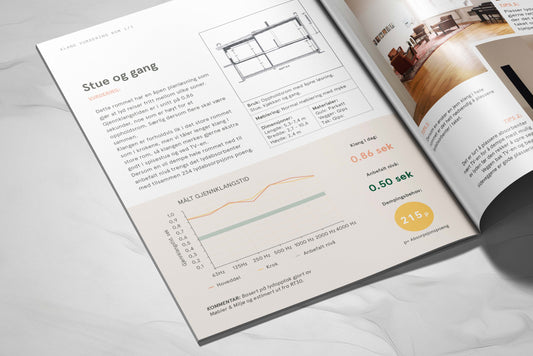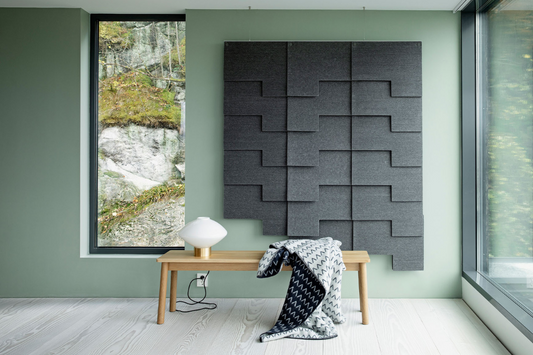Is it possible to get an echoey room to sound normal? In this blog I’m going through all the steps we take to figure out how to make your space sound great.
So what makes a room sound echoey? Well, every room has its own acoustic properties. If you make a loud pop, and measure how long the sound lingers, then that's your reverberation time. If sound lingers for a long time, the room sounds echoey. If the room goes quiet quickly, the reverberation time is short. You probably won't even think of what the room sounds like because it just sounds normal.
What a room sounds like relates to what materials are used, how big it is and how it's been furnished. And what sound characteristics you want, depends on what the room is used for.
For example:
When I was a student I sang in a choir. Once, we were lucky enough to sing at a Christmas concert in the Nidaros Cathedral. It was magical. No microphones, no speakers. And still, our voices filled the entire space. It was an incredible experience and everyone agreed that the acoustics was fantastic.
But the same level of reverberation at home? A loud echoing chorus of Peppa Pig on the TV, plates clanging on the tabletop, and every conversation spreading through the whole house? No, thanks.
So how do we reduce echo when there's just tooo much of it?
So yes, sometimes the echo has got to go. But how much reverberation is just right? And how many sound absorbers will you need to get there? Every room is unique, and there’s no one size fits all answer. That's why we offer a free room evaluation. These are the five points we consider to figure out what your space needs:
1. How much echo is there?
2. What is right amount of reverberation for your space?
3. What products would you like to use?
4. How many sound absorbers you need
5. Where should you to place them?
1. How much echo are you experiencing?
Think your space is too echoey? Well, then you're probably right. But how much echo are we talking about?
It’s possible to calculate the reverberation time based on the room geometry. The problem is that it’s hard to account for everything. You´ll probably end up with an estimate that’s too high. And that will make it look like you’ll need more sound absorbers than you really do. Sound absorbers aren’t cheap, so the last thing you want is to buy more than you need.
The best way to find out how much echo you have is to measure it. By making a loud pop, and measuring how long it takes for the sound level to drop to 60 Db, we’ll find the reverberation time (RT60).
Now the cool thing is that we can even find the RT60 from a recording. That's how we can offer you a free room evaluation. You send us a recording made on your phone, and we'll analyze it to find out how much echo you have. Getting the reverberation time right means we´ll be able to give you some solid advice on how many absorbers you need. This way you avoid buying too few, or too many.
2. What should your space sound like?
The next question is: What’s the right amount of reverberation in your space? You're living room shouldn't sound like a cathedral. Obviously.. But you don't want to dampen it too much either. That would make your space sound flat and dull. And you’d want to avoid that. Especially if you like to turn up your stereo once in a while.
You´ll find well defined requirements for reverberation time in classrooms, offices and restaurants. For homes on the other hand, there's very little. We use the Norwegian standard NS-8175:2019, and all it says for homes is that the reverberation time should be considered if it's above 0.5 seconds. In other words.. Just about all homes with an open plan and minimalist interior.
In order to consider the reverberation time of your space, we take into account the shape and size of your room, what you use it for, and how you find the acoustics problematic.
3. Which sound absorbers would you favor?
It's easy to choose sound absorbers based primarily on what they look like. I get it. But remember, you’re trying to get rid of the echo so you need to know how effective they are as well.
There’s a lot of misconceptions about what can dampen sound. Like “you can use large plants”, or “ just get some pictures up”. Now, large plants can help spread sound around, but it won’t absorb it. And hanging pictures on your walls just won´t do it. (unless it's a sound absorber with a photo printed on it!).
It's so frustrating to see products being described as sound absorbing, when in reality they have next to ZERO effect. It’s misleading. Many people are really struggling with echo, but they don´t know what to look for. It's so quick to choose the wrong product, and suddenly you've spent a lot of money on something that doesn't work.
Now, at least that won’t happen to you. To help you out I've made you a list: The five of the 5 biggest misconceptions about sound absorbers, so you don't waste money. You can find that
here.
So, where were we? Ah, Yes. Sound absorbers.
How efficient the sound absorber is, determines how many you’ll need. If you choose an efficient sound absorber you’ll need to cover less area. You can get the same result with a less efficient absorber, BUT you’d have to cover a larger area. Now if you have a limited amount of wall space, make sure you get the most out of the area you choose to cover.
4. How many sound absorbers do you need?
Now this is strangely enough the easy part. Once we know …
- The reverberation time of your room
- Which sound absorbers you want to use
- What you want your room to sound like
Then we can calculate exactly how many sound absorbers you´ll need to get there. But let’s just consider point 3. a little further. The recommended reverberation time for a home is about 0.5 seconds. But if you’re living in a house where the reverberation time is 1 second, bringing it down to 0.6 seconds makes a big difference. At this point it’s fair to consider if that’s good enough, or if you want to invest what it takes to dampen the space even further. We’ll help you consider this as a part of your room evaluation.
5. Where to place the sound absorbers
The amount of sound absorption you put in, is the most important step towards a space that sounds good. But if you place the sound absorbers correctly, you´ll get more out of them. Here are some tips:
- Spread them around
Creating a good balance of sound absorbers around the room is important. If the sound absorbers are clumped in one area, that specific area might feel better, but the rest of the room will still be echoey. So make sure they’re evenly spread out.
- Place them near the sound source
Let’s say that the dinner table conversation is heard loud and clear, even downstairs. Place the sound absorbers close to where the conversation is happening. So, on nearby walls or down from the ceiling above the table.
- Place the absorbers on large surfaces facing each other
Echo loves bouncing back and forth between parallel surfaces like large walls or windows. That’s why it spreads so well through hallways for example.You can deal with this by placing sound absorbers on one of the surfaces. That will stop the sound from bouncing back. Or, let’s say you have a large window and a big wall right across from it? Well, then that wall would be a great place for a sound absorber.
- The ceiling
The ceiling is a large and bare surface that reflects sound well. Often, it’s the key location for sound absorbers. Especially if you have a high or sloped ceiling. There’s plenty of space and it's easy to spread the absorbers out evenly.
- Corners
Fun fact - sound accumulates in the corners. If you’re struggling with long reverberation from bass tones, then creating a bass trap in a corner is a handy trick. Felt Tile Slanted can easily be placed across a corner to catch the basse.
Aaaand, we’re done. Well done for making it to the end!
If you have any questions or comments then I'd love to hear from you. Comment below or send an email to team@rom-tonik.com




